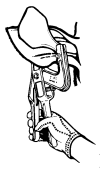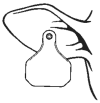Y-Tex OPtimizer Insecticide Cattle Ear Tag
This treatment applies to the following species:ORGANOPHOSPHATES
GROUP 1B INSECTICIDE
For use on Beef and Non-Lactating Dairy Cattle
Controls:
Horn Flies
(including pyrethroid resistant populations)
Lice
Gulf Coast Ticks
Spinose Ear Ticks
Aids to Control:
Face Flies
Lice
Keep Out of Reach of Children
Y-Tex OPtimizer Insecticide Cattle Ear Tag Caution
|
ACTIVE INGREDIENT: |
BY WEIGHT |
|
Diazinon |
21.00% |
|
OTHER INGREDIENTS |
79.00% |
|
TOTAL |
100.00% |
● Two tags per animal give up to five month’s control of pyrethroid-resistant horn flies.
● Two tags per animal control lice, Gulf Coast ticks, spinose ear ticks, and provide substantial reductions of face flies during summer season.
● Two tags per animal control biting lice, little blue cattle lice, and provide substantial reductions of other sucking lice during winter season.
● Guaranteed against loss due to tag or button failure.*
● No withdrawal time required.
Snap-Lok® collar for guaranteed retention*
Ribbed design for season-long durability
Long taper and rounded edges for durability
Large surface area for insecticide effectiveness
Guarantee
*This guarantee is a limited guarantee, limited to the replacement of tags only, if the tags failed after being properly applied, to remain in the animal’s ear for a five (5) month period due to tag breakage or separation from button.
Directions For Use
It is a violation of Federal law to use this product in a manner inconsistent with its labeling. Reformulation or repackaging of this product is prohibited. The labeling must be in the possession of the user at the time of pesticide application.
Resistance-management Recommendations. For resistance management, OPtimizer Insecticide Cattle Ear Tag contains a Group 1B insecticide. Any pest population may contain individuals naturally resistant to OPtimizer Insecticide Cattle Ear Tag and other Group 1B insecticides. The resistant individuals may dominate the pest population if this group of insecticides are used repeatedly in the same herds. Appropriate resistance management strategies should be followed.
Summer Season: For optimum control of horn flies, lice, Gulf Coast ticks, spinose ear ticks, and to aid in the control of face flies, attach two ear tags per animal (one in each ear) in May to June or when flies become a problem in the spring. Provides up to five month’s control of horn flies, including pyrethroid-resistant horn flies.
Winter Season: To control lice during winter season, apply two new tags per animal in late fall. Kills cattle biting lice within two weeks. Controls little blue cattle lice and aids in control of longnosed and shortnosed cattle lice.
Apply new tags in spring for fly and tick control. Replace as necessary. Apply as shown with the Y-TEX 2-piece tagging system. All animals in the herd should be tagged. Calves less than 3 months of age should not be tagged or ear damage may result. To minimize development of insecticide resistance, remove used tags at end of fly and lice seasons and follow Y-TEX’s recommended tag rotation program.

Step 1
Seat male button firmly on pin, press down and give a slight twist.

Step 2
Place female tag firmly under clip. Collar on tag must be pointing away from pin.

Step 3
Position applicator over ear and squeeze the handles together.

The ideal position for male stud is between the second and third radial cartilage as shown.
Storage And Disposal
Do not contaminate water, food or feed by storage or disposal.
PESTICIDE STORAGE: Store in original container in a cool place away from direct sunlight.
Opened bags containing ear tags should be resealed for storage.
PESTICIDE DISPOSAL: Remove tags before slaughter. Securely wrap used tags in a plastic bag or several layers of newspaper and discard in trash.
CONTAINER DISPOSAL: Do not reuse bag. Discard bag in trash.
First Aid
This product contains diazinon, an organophosphate insecticide that inhibits cholinesterase.
If on skin
• Rinse skin immediately with plenty of water for 15-20 minutes.
• Call a poison control center or doctor for treatment advice.
If in eyes
• Hold eye open and rinse slowly and gently with water for 15-20 minutes. Remove contact lenses, if present, after the first 5 minutes, then continue rinsing eye.
• Call a poison control center or doctor for treatment advice.
If swallowed
• Call a poison control center or doctor immediately for treatment advice.
• Have person sip a glass of water if able to swallow.
• Do not induce vomiting unless told to do so by a poison control center or doctor.
• Do not give anything by mouth to an unconscious person.
Hot Line Number
Have the product container or label with you when calling a poison control center or doctor, or going for treatment. You may also contact 1-800-255-3924 for emergency medical treatment information.
Note To Physician
Diazinon is an organophosphate insecticide. If symptoms of cholinesterase inhibition are present, atropine sulfate by injection is antidotal. 2-PAM is also antidotal and may be administered, but only in conjunction with atropine.
Precautionary Statements
HAZARDS TO HUMANS AND DOMESTIC ANIMALS
Y-Tex OPtimizer Insecticide Cattle Ear Tag Caution
Harmful if swallowed. Causes moderate eye irritation. Avoid contact with eyes or clothing. Wash thoroughly with soap and water after handling and before eating, drinking, chewing gum, using tobacco or using the toilet. Wear chemical-resistant gloves made of rubber or any waterproof material (thickness equal to or greater than 14 mils) when applying tags.
Personal Protective Equipment (ppe)
Applicators and other handlers must wear:
• long sleeved shirt and long pants
• shoes and socks
• chemical-resistant gloves made of rubber or any waterproof material (thickness equal to or greater than 14 mils).
User Safety Requirements
Follow manufacturer’s instructions for cleaning/maintaining PPE. If no such instructions for washable exist, use detergent and hot water. Keep and wash PPE separately from other laundry.
User Safety Recommendations
Users should wash hands before eating, drinking, chewing gum, using tobacco, or using the toilet. Users should remove clothing/PPE immediately if pesticide gets inside. Then wash thoroughly and put on clean clothing. Users should remove PPE immediately after handling this product.Wash the outside of gloves before removing.As soon as possible, wash thoroughly and change into clean clothing.
Environmental Hazards
This pesticide is highly toxic to birds, fish, and other wildlife. Do not apply directly to water. Do not contaminate water by disposal of used tags. Use this product only as specified on the label.
Notice Of Warranty
Y-TEX CORPORATION MAKES NO WARRANTY OF MERCHANTABILITY, FITNESS FOR ANY PURPOSE, OR OTHERWISE, EXPRESSED OR IMPLIED concerning this product or its uses which extend beyond the use of the product under normal conditions in accord with the statements made on the label, and in any case, is limited to replacement of tags only.
EPA EST. NO. 39039-WY-01
EPA REG. NO. 39039-3
Y-TEX CORPORATION, 1825 BIG HORN AVENUE, CODY, WYOMING 82414
MADE IN USA
|
NET WT. |
CONTENTS: |
|
|
0.53 oz. (15 grams) PER TAG |
20 EAR TAGS |
YTP-34-0521 |
|
0.53 oz. (15 GRAMS) PER TAG |
5 POUCHES OF 20 TAGS EACH RANCH PACK |
YTP-35-913 |
CPN: 1344011.3
1825 BIG HORN AVENUE, CODY, WY, 82414
| Telephone: | 800-443-6401 | |
| Website: | www.y-tex.com | |
| Email: | ytexinfo@y-tex.com |
 |
THIS SERVICE AND DATA ARE PROVIDED "AS IS". DVMetrics assumes no liability, and each user assumes full risk, responsibility, and liability, related to its use of the DVMetrics service and data. See the Terms of Use for further details. |

Copyright © 2025 Animalytix LLC. Updated: 2025-08-27
